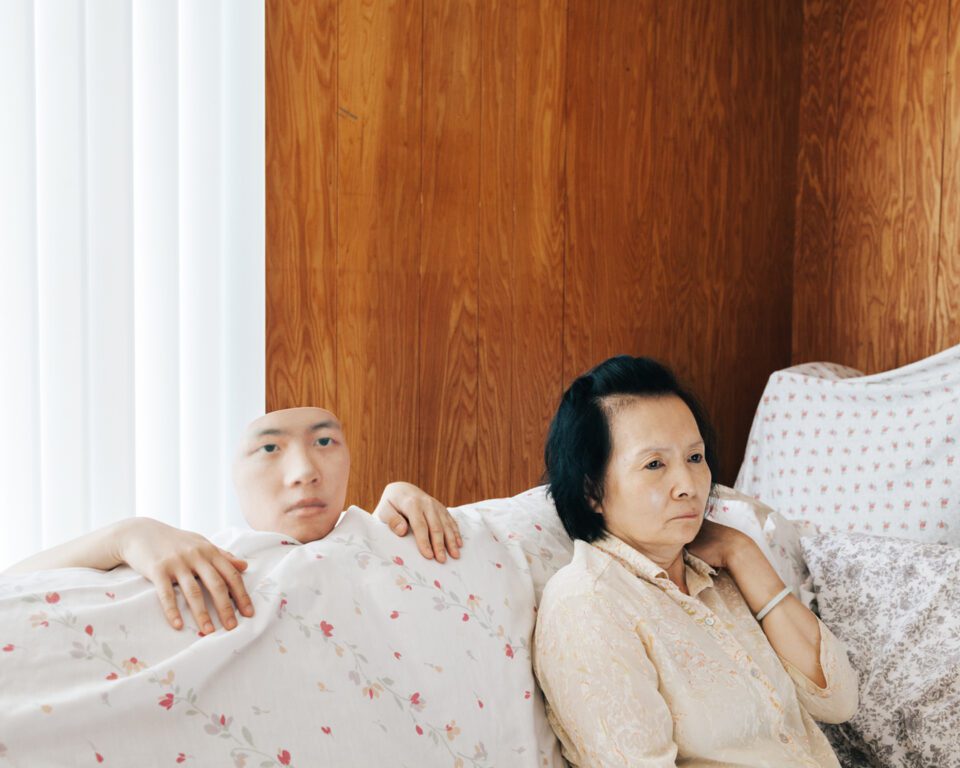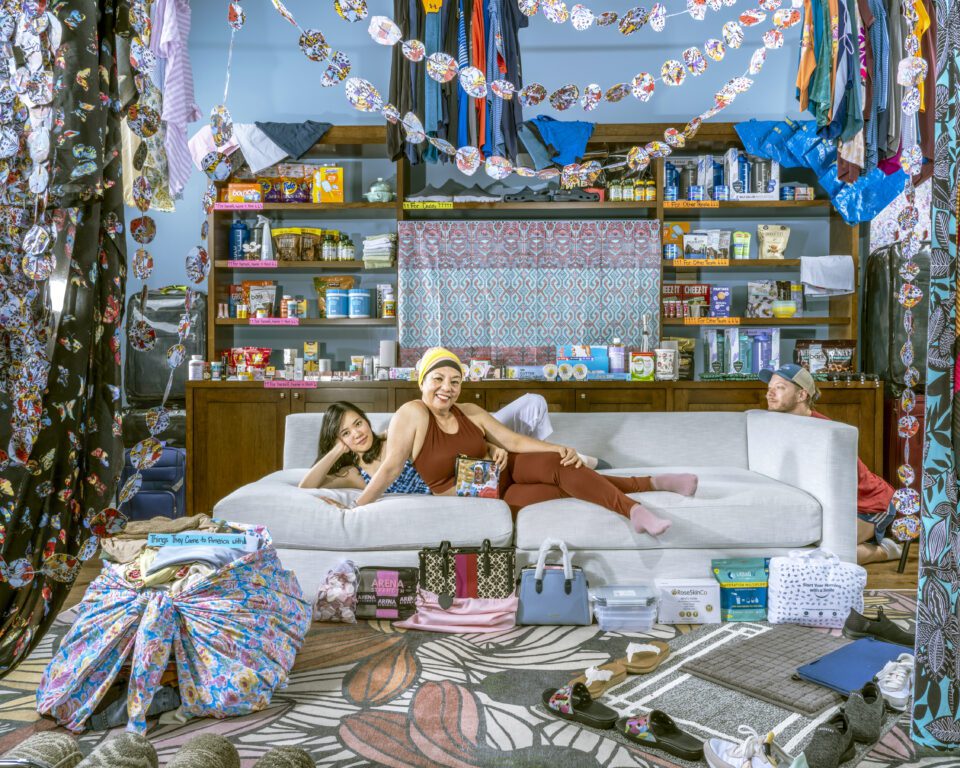“Home is where we spend so much of our lives, but we overlook it as a subject,” states Karni Arieli, the photographer best-known for Eye Mama (2023), a curated body of work focusing on motherhood and domestic life. “I think that the crop comes very much out of motherhood because it’s always haphazard. How the kid sits on your head, the way you’re falling over, how much you’re exhausted. It’s very hard to frame up perfectly as a mother and motherhood isn’t perfect.” Arieli’s Instagram @eyemamaproject, has garnered more than 20,000 followers. There’s certainly an appetite for raw and honest representations of parenthood, and its against this backdrop that Yancey Richardson’s latest exhibition, Intimate Strangers, arrives. Rather than from the perspective of a guardian, the show presents artists documenting and observing their own parents. Through a series of highly personal and poignant photographs, 17 image makers reflect on diverse social issues, including the pursuit of the American dream, stigmas around LGBTQ+ concerns, as well as topics related to Black masculinity, immigration and substance abuse. In moments of honesty and tenderness, this show grapples with the complexities that exist within familial life.

One example of this is LaToya Ruby Frazier (b. 1982), who blurs the line between documentary and portraiture. In Momme (top of page), Frazier’s mother looks downward, her face parallel with the frame. In the background looms LaToya, who looks head-on at the camera. Her mother wears a floral satin shirt whilst LaToya dons a white halter neck. The black and white image verges on quiet reverence. From this angle, the women share everything. Each has an ear and eye on display; both wear hairnets. Their two profiles are entangled in a physical and irrevocable interlinking. Frazier grew up in blue-collar devastation, as she watched the drug epidemic infiltrate and tear apart her Pennsylvanian community. The artist documents the difficult and emotionally charged process of growing up with a parent who fought addiction. She told the The Morning News, “We both have so much angst and anger with one another and most of that is due to the fact that my grandmother had to play the role of mother to me, which made us more or less rival siblings. You can look at those images of me and my mother standing side-by-side and you can tell that I’m guarded, I’m more controlling.” Outline is everything. In the photograph, the two women’s lips line up so perfectly that they appear to bloom into each other. Frazier notes, “We’ve swapped roles, but ultimately, she is my mother. She has yet to admit it, but this is also maybe her way of trying to reconcile.”
Further explored is the notion of Black masculinity. In his series, American Mother American Father (2022), Zora J Murff (b. 1987) draws on vernacular and family pictures, combining these with newly produced work that challenges racial stereotypes. The resulting portraits are understood to be “affirmations,” as the artist learns to unpick and remake himself in his own image. Murff says, “My early series were made when I was experiencing rapid upward social mobility and becoming acquainted with Arkansas and Mississippi, my ancestral landscapes. Visiting the birthplaces of my maternal and paternal families forced me to reflect on how we build identity, how identity can be created for us, and how those phenomena collide.”


Elsewhere, artists such as Jarod Lew (b. 1987) explore what it means to be born to immigrant parents. Lew unravels the story of a parent whose past life had previously been hidden. His mother had been engaged to Vincent Chin, an American draftsman of Chinese descent who was killed in a historic hate-crime in 1982. The discovery was painful, and shocking. Chin was murdered by two auto workers who blamed him for the massive lay-offs occurring in the automotive industry. The downturn in business at the time contributed to a widespread Anti-Asian xenophobia across the United States, a crisis which is still ongoing.
Lew only learned of his mother’s relationship years after Chin’s death. As Howie Chen writes in ArtForum, “It would take another four years before Lew could approach his mother about her past and the tragedy that had been kept outside the frame of his life. During that time, his practice shifted to explore the nature of unspeakable loss and the solitude that weighs on a society unable to mourn the death of people, industries, and cities.” His work grieves an absence that is unreachable, holding onto a dislocated sadness for what could have been. This is reflected in the photograph’s titles – labelled Untitled. Only in the bracketed heading, such as (Cutting Flowers) or (Mom by Window), can meaning be extricated. In one scene, a manicured nail points to a black and white image of Lew’s mother in her youth. In another, she sits by a window in the orange glare of the afternoon. The light threatens to wash out her face completely, although, upon a closer viewing, a viewer can her on the brink of tears, her eyes glassy and wet.

This experience of bottled up anguish is also reflected in the work of Tommy Kha, who fled with his mother to Memphis from Vietnam in the 1980s. Similarly to Lew, whilst growing up, Tommy Kha’s mother did not talk about her past. On venturing into her closet, he discovered photographs from when she was younger, presenting “snapshots of friends gathered around plates of food or birthday cakes, self-portraits on a pier, at the beach, with enormous stuffed animals, or perched in a tree.” As Hua Hsu writes in Aperture, the suggestion was that, “these pictures weren’t art, just moments from a past she never discussed.”
Kha’s portraits employ a surreal level of curiosity and play. They consider fragmentation from a distinctly literal perspective. The artist captures resting shots of his mother, sat on a couch or at the kitchen table, placing them alongside his own collaged face in the foreground. Kha’s profile appears as a two-dimensional mask – a theatrical cut-out oval. The whole thing looks flat enough to be paper or thin enough to be a porcelain shell, threatening to fold over and crumple, or shatter, at any moment. In scenes of unspoken domesticity, these pictures point to what it means to fit into a space that is already yours. They observe life on the precipice of assimilation. And they nod to questions of belonging and presence, playing in a guise that is reminiscent to the masked bodies of Gina Osterloh. What does it mean to see the self represented? The artist explains, “I’m a cut of my mom. Every photograph I make of her is a Half Self-Portrait.” The resulting series pays homage to the weight of inheritance.

Finally, the bright and eclectic tableaux of Leonard Suryajaya (b. 1988) engage in absurdity, affection and humour. Bric-a-brac and consumer items spread across rooms, combining capital from American and Indonesian life. This is demonstrated in Mom and Everything She Bought in America, where the artist’s mother and daughter grin on two-seater couch, encompassed by a treasure trove of bulk-buy foods, suitcases, medicines and plastic water bottles. Peering out of the side of the image is Suryajaya’s husband, clad in a baseball hat and sports shorts. The image is a kaleidoscope of colour, as each surface is covered by a new item or textile. Suryajaya juxtaposes culturally coded objects, such as IKEA bags or Cheez-It crackers, as he looks at the relationship of gender, heritage and sexuality. The artist explains to Metal Magazine, “Growing up a closeted queer in an Islamic majority country, being a racial minority in Indonesia, feeling oppressed and suppressed – I was just a confused human…I want the first impression of my work to be celebratory and ambiguously joyous. It is a rendering of hopeful progress without shying away from the mess of the current time or the past.”
Intimate Strangers tests the boundaries of community and family. It carves out a powerful visual language, specific to each image maker. There is a latent sense of tension, sitting just below the surface of the child-parent bond. These are not resolved childhoods, but demanding, messy and laborious dynamics, punctuated by absence and grief. At the same time, these are also startlingly authentic depictions of growing up, as images come to terms with fallibility, loss and love. Yancey Richardson draws out an exhibition that is rooted in sincerity, in a reckoning of one of the most important relationships of all.
Yancey Richardson | Until 18 August
Words: Chloe Elliott
Image Credits:
1. La Toya Ruby Frazier, Momme (2008)
2. Jarod Lew Untitled (Pictures of Mom) (2021) from the series In Between You and Your Shadow
3. Zora J Murff, American Mother (2019)
4. Jarod Lew Untitled (Mom by Window), 2023 from the series In Between You and Your Shadow
5. Tommy Kha, Headtown V, Whitehaven, Memphis (2019)
6. Leonard Suryajaya, Mom and Everything She Bought in America, 2023Tommy Kha





